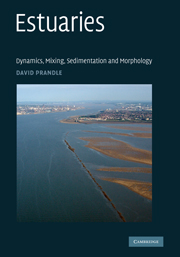Book contents
- Frontmatter
- Contents
- List of symbols
- 1 Introduction
- 2 Tidal dynamics
- 3 Currents
- 4 Saline intrusion
- 5 Sediment regimes
- 6 Synchronous estuaries: dynamics, saline intrusion and bathymetry
- 7 Synchronous estuaries: sediment trapping and sorting – stable morphology
- 8 Strategies for sustainability
- Index
- References
6 - Synchronous estuaries: dynamics, saline intrusion and bathymetry
Published online by Cambridge University Press: 01 September 2009
- Frontmatter
- Contents
- List of symbols
- 1 Introduction
- 2 Tidal dynamics
- 3 Currents
- 4 Saline intrusion
- 5 Sediment regimes
- 6 Synchronous estuaries: dynamics, saline intrusion and bathymetry
- 7 Synchronous estuaries: sediment trapping and sorting – stable morphology
- 8 Strategies for sustainability
- Index
- References
Summary
Introduction
Previous chapters illustrated the nature of tidal elevations, currents, saline intrusion and sediment regimes in estuaries of varying sizes and shapes over a range of tidal, alluvial and river flow conditions. Here, we address the more fundamental question of how morphology is itself determined and maintained by the combined actions of tidal dynamics and the mixing of river and salt waters.
As in these earlier chapters, considerable simplifications are necessary to obtain generic analytical solutions to the governing equations. Here, we restrict consideration to strongly tidal, funnel-shaped ‘synchronous’ estuaries. Adopting the linearised 1D momentum and continuity equations, the focus is on propagation of a single predominant (M2) tidal constituent. Since estuaries often involve significant differences in surface areas between low and high water, a triangular cross section is assumed.
Section 6.2 indicates how these approximations enable localised values for the amplitude and phase of tidal current U* to be determined in terms of depth, D and elevation amplitude, ς*. A further expression for the slope of the sea bed, SL, enables both the shape and the length, L, of an estuary to be similarly determined.
Various derivations for the length of saline intrusion, LI, were discussed in Chapter 4, based on the expedient assumption of a constant (in time and depth) axial density gradient Sx. All indicated a dependency on D2/fU* U0, where U0 is the residual river flow velocity and f is the bed friction coefficient.
- Type
- Chapter
- Information
- EstuariesDynamics, Mixing, Sedimentation and Morphology, pp. 151 - 174Publisher: Cambridge University PressPrint publication year: 2009



